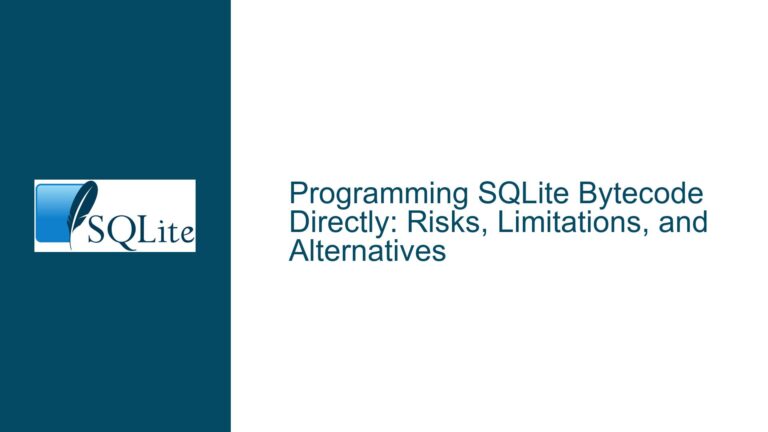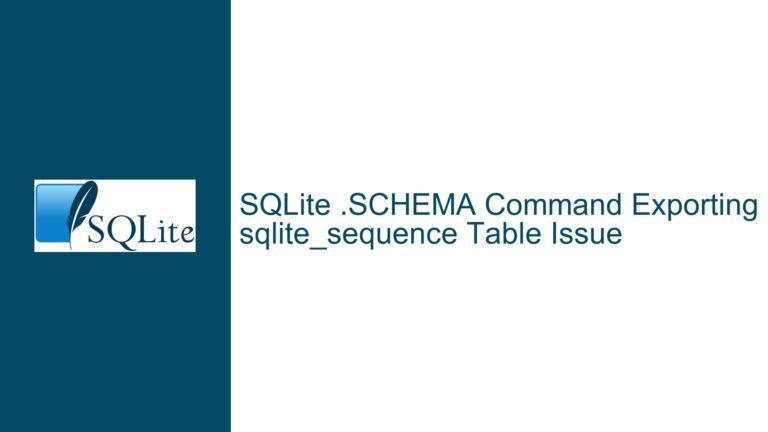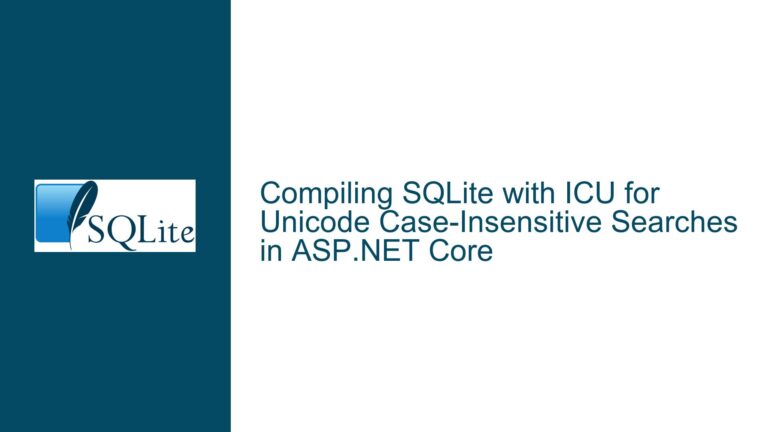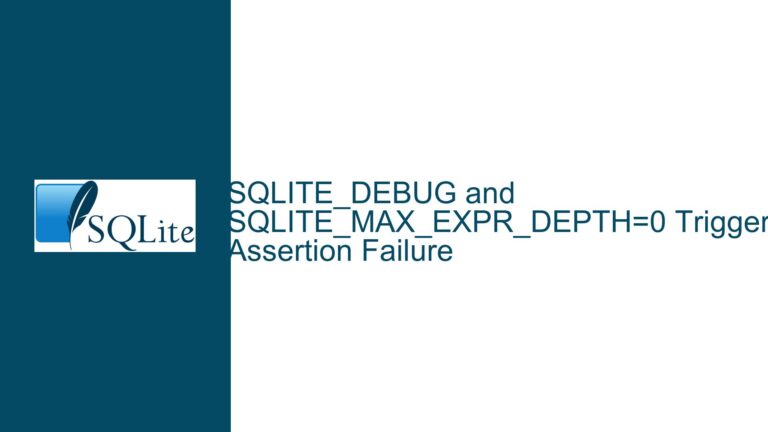Efficiently Binding Multi-Chunk Blobs and Text in SQLite Without Unnecessary Memory Copies
Scatter/Gather Binding for Multi-Chunk Blobs and Text in SQLite
Issue Overview
The core issue revolves around the inefficiency of binding large multi-chunk blob and text values in SQLite. Currently, SQLite requires that these values be contiguous in memory before they can be bound to a prepared statement. This necessitates allocating a large array and performing a memcpy operation to concatenate the chunks, which is both memory-intensive and computationally expensive. This process becomes particularly problematic when dealing with large datasets or systems with limited resources, as it can lead to significant performance bottlenecks.
The discussion highlights the need for a more efficient method to bind multi-chunk blob and text values directly, without the need for intermediate memory allocation and copying. The proposed solution involves implementing a scatter/gather binding mechanism, similar to the struct iovec concept used in other systems like Boost.ASIO. This mechanism would allow SQLite to accept multiple non-contiguous memory chunks as a single value, thereby eliminating the need for memcpy operations and reducing memory overhead.
The scatter/gather approach is not novel; it is a well-established pattern in systems programming, particularly in scenarios involving asynchronous I/O operations. By adopting this pattern, SQLite could significantly improve its performance and flexibility when handling large blob and text values. The discussion also touches on the limitations of the current incremental I/O interface for blobs, which, while useful, does not provide the same level of convenience and flexibility as direct binding.
Possible Causes
The inefficiency in binding multi-chunk blob and text values in SQLite can be attributed to several factors. First, SQLite’s current binding API is designed with the assumption that the data to be bound is contiguous in memory. This design choice simplifies the internal implementation but imposes a significant burden on the user when dealing with non-contiguous data. The user is forced to allocate a large contiguous memory block and copy the data into it, which is both time-consuming and resource-intensive.
Second, the incremental I/O interface for blobs, while providing an alternative to direct binding, is not as convenient or flexible. It requires the user to first insert a placeholder value, then open the blob for incremental writing, and finally write the data in chunks. This process is more cumbersome than direct binding and does not apply to text values, limiting its usefulness in scenarios where both blob and text values need to be handled efficiently.
Third, the lack of a standardized scatter/gather binding mechanism in SQLite’s API means that users must resort to workarounds, such as using the carray extension, which is not part of the public API and may not be portable across different platforms. This lack of standardization makes it difficult for users to implement efficient and portable solutions for handling multi-chunk data.
Finally, the discussion suggests that the current API design does not fully leverage modern programming paradigms and libraries, such as Boost.ASIO, which have successfully implemented scatter/gather mechanisms for asynchronous I/O operations. By not adopting these patterns, SQLite may be missing out on opportunities to improve its performance and usability in scenarios involving large or non-contiguous data.
Troubleshooting Steps, Solutions & Fixes
To address the inefficiency of binding multi-chunk blob and text values in SQLite, several steps can be taken to implement a scatter/gather binding mechanism. The following solutions and fixes outline a comprehensive approach to resolving this issue:
1. Implementing a Scatter/Gather Binding API:
The first step is to extend SQLite’s API to support scatter/gather binding for blob and text values. This can be achieved by introducing new functions, such as sqlite3_bind_blob_iovec and sqlite3_bind_text_iovec, which accept an array of sqlite3_iovec structures. Each sqlite3_iovec structure would contain a pointer to a memory chunk and its length, allowing SQLite to bind multiple non-contiguous chunks as a single value.
The sqlite3_iovec structure could be defined as follows:
struct sqlite3_iovec {
void* iov_base;
size_t iov_len;
sqlite3_destructor_type iov_free;
};
The iov_free field would allow the user to specify a destructor function for each chunk, providing flexibility in managing memory.
2. Handling Memory Management:
To ensure proper memory management, the new API should support both static and transient binding options. Static binding would indicate that the memory chunks are managed by the user and will not be freed by SQLite, while transient binding would allow SQLite to take ownership of the memory and free it after the binding is complete. This can be achieved by defining appropriate destructor types, such as SQLITE_STATIC_IOVEC and SQLITE_TRANSIENT_IOVEC.
3. Integrating with Existing APIs:
The new scatter/gather binding API should be designed to integrate seamlessly with SQLite’s existing binding functions. This would allow users to choose the most appropriate binding method based on their specific use case, without requiring significant changes to their existing code. For example, users could continue to use sqlite3_bind_blob and sqlite3_bind_text for contiguous data, while switching to sqlite3_bind_blob_iovec and sqlite3_bind_text_iovec for non-contiguous data.
4. Optimizing Performance:
To maximize performance, the new API should be optimized for both small and large data sets. This could involve implementing efficient memory management strategies, such as using memory pools or custom allocators, to reduce the overhead of managing multiple memory chunks. Additionally, the API should be designed to minimize the number of system calls and memory copies, ensuring that the scatter/gather binding process is as efficient as possible.
5. Providing Documentation and Examples:
To facilitate adoption, comprehensive documentation and examples should be provided to help users understand and use the new scatter/gather binding API. This documentation should cover common use cases, best practices, and potential pitfalls, ensuring that users can effectively leverage the new API in their applications. Additionally, sample code and tutorials could be provided to demonstrate how to use the API in real-world scenarios.
6. Addressing Compatibility and Portability:
The new scatter/gather binding API should be designed with compatibility and portability in mind. This includes ensuring that the API works consistently across different platforms and compilers, and that it does not introduce any breaking changes to existing applications. Additionally, the API should be tested extensively to ensure that it behaves correctly in a wide range of scenarios, including edge cases and error conditions.
7. Exploring Alternative Solutions:
While the scatter/gather binding API provides a direct solution to the problem, it is also worth exploring alternative approaches that could achieve similar results. For example, the incremental I/O interface for blobs could be extended to support text values, providing a more unified approach to handling large data. Additionally, the carray extension could be formalized and integrated into the public API, providing users with a portable and standardized way to handle non-contiguous data.
8. Gathering Feedback and Iterating:
Finally, it is important to gather feedback from the SQLite user community and iterate on the design and implementation of the new API. This could involve conducting surveys, soliciting feedback on mailing lists and forums, and engaging with users to understand their specific needs and pain points. Based on this feedback, the API could be refined and improved to better meet the needs of the community.
In conclusion, implementing a scatter/gather binding mechanism in SQLite would provide a significant performance improvement for applications that need to handle large multi-chunk blob and text values. By extending the API to support non-contiguous data, SQLite can reduce memory overhead, improve performance, and provide users with a more flexible and efficient way to bind large values. The proposed solutions and fixes outlined above provide a comprehensive approach to addressing this issue, ensuring that SQLite remains a powerful and versatile database engine for a wide range of applications.






